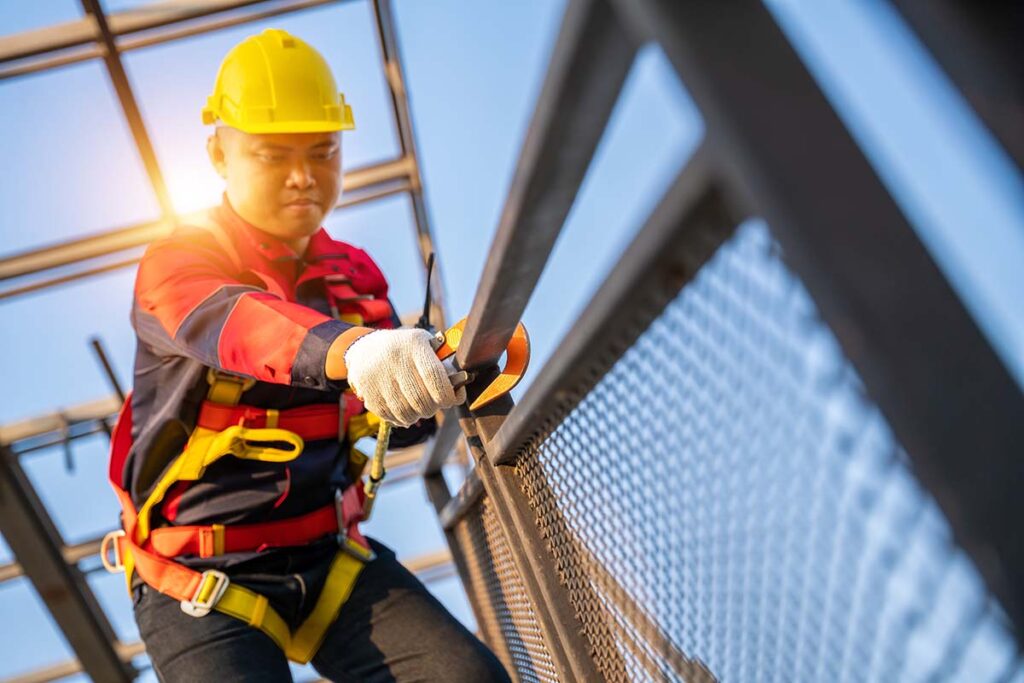Scaffolding Safety Tips for Workers
Working at height is a hazardous job and requires the utmost safety precautions. It’s important to understand scaffolding safety tips to ensure necessary safety measures.
When you’re on a construction site, understanding and practicing scaffold safety isn’t just a requirement — it’s what stands between you and potential accidents.
Working on elevated structures comes with serious responsibilities that extend beyond your own wellbeing. Your actions and attention to safety protocols directly affect everyone working below and around you.
From basic platform setups to complex multi-level configurations, there’s a set of proven practices that keep your entire team protected while getting the job done. We’re going to walk you through the key steps to keep you secure while working up high.
You’ll learn about structural requirements, workplace controls, and the right protective equipment to use. These field-tested guidelines will help you handle the challenges of working at elevation with confidence and care.
Table of Contents
Scaffolding Safety tips
Training for Scaffolding Assembly and Use
Scaffolding is an essential tool used in many construction and repair jobs. That’s why it’s important to ensure that everyone who assembles or uses scaffolding is properly trained and competent. Workers should be educated on the safe use of scaffolding products, including proper assembly, inspection and placement.
Following the right scaffolding safety practices can mean the difference between a successful project and a serious accident. Regular hands-on training sessions help reinforce these critical skills. Make safety training a priority by scheduling it before any new project begins.
Training should cover the major elements of scaffolding use, such as:
- Identifying the types of scaffolds used for a particular job
- Inspecting components for any defects prior to assembly
- Assembling components per manufacturer instructions
- Identifying any other pieces of personal protective equipment that may be needed
- Properly positioning and securing the scaffold frame and guardrails
- Understanding any limitations or restrictions on the use of the scaffold
- Recognizing what changes to look for when inspecting during use.
It’s also important to note that workers should receive periodic scaffolding safety training and refresher courses. Especially if there have been changes to approved scaffolding methods or new components have been introduced.
With the right scaffolding training, construction workers can work confidently knowing how to stay safe when working on their projects.
Inspect All Scaffolding Components Before Use
When it comes to scaffolding safety, one of the most important steps is to inspect scaffolding components before use. As a construction worker, it’s your responsibility to check for any signs of deterioration. Such as corrosion, wear and tear, damaged connections, loose components or any other issues that could be hazardous when working with scaffolding.
Make it a habit to check every connection point and support member before starting your shift to ensure scaffold safety. Pay special attention to areas where water might collect and cause rust, or spots that bear the most weight during use.
Don’t assume that because the scaffold was safe yesterday, it’s still safe today — weather conditions and overnight temperature changes can affect structural integrity in ways that aren’t immediately visible.
In general, inspect for:
- Visual damage or wear & tear
- Corrosion from rain or weathering
- Faulty joints & components
- Incorrectly assembled parts
- Loose nuts and bolts
Keep in mind that there are several different types of scaffolding available for use. Regardless of the type you’re working with you should always make sure that it is checked by a certified expert at least once a year and prior to each job. Additionally, don’t be afraid to ask questions if you’re unsure about something. A lack of knowledge can easily lead to an accident on the worksite.
Follow the Manufacturer’s Specifications
When it comes to scaffolding safety, it is essential that construction workers follow the manufacturer’s specifications. This includes using the right type of scaffolding for the job, understanding its capacity and weight limits, and ensuring components are properly assembled on site.
Capacity Limits
The capacity limit is one of the most important factors when it comes to scaffolding safety. The maximum number of workers and materials permitted on a specific scaffolding must never be exceeded. As this could lead to accidents or even collapse. When in doubt, refer to the manufacturer’s manual or consult a professional.
Weight Limits
Weight limits are also essential for maintaining safe working conditions. Every piece of scaffolding has an individual load limit, and these must be adhered to at all times in order to ensure worker safety and keep the structure from collapsing. Additionally, make sure that you distribute any loads evenly across various sections so as not to overload specific areas.
Assembly Instructions
Assembling a scaffold can be complicated. If there is any confusion about how to assemble it correctly, refer back to the instructions provided by the manufacturer first and foremost – don’t guess! Failing to properly assemble a scaffold can result in weak points that may compromise its stability during use.
Ensure Scaffolds Are Level and Stable
Before climbing any elevated platform, you need to understand the basic scaffolding safety requirements. Start by checking that your scaffold’s base is level and secure — this is your foundation for safe working conditions.
Clear away any debris or obstacles that might cause instability, and always inspect components for damage, rust, or wear before starting your shift.
Test your scaffold’s stability by applying firm pressure to planks and supports. If you notice any give or movement, that’s a red flag — the structure isn’t secure and needs repair before anyone steps foot on it.
It’s also important to keep an eye out for any shifting or sagging along the length of the scaffold, which could indicate an issue with balance or loose parts.
Secure all adjustable components in place, and use only approved braces, outriggers, ties, guys, and anchors in accordance with OSHA regulations when necessary. If you’re working on a particularly tall structure, make sure you double check all upright members to ensure they are still true vertically because if they are not, they could lead to catastrophic failures.

Guardrails and Toe boards for Fall Protection
When you are working on scaffolding, scaffolding safety equipment is essential. Guardrails and toe boards should be installed to guard against falls from dangerous heights.
The guardrails should be between 39 and 45 inches, with a maximum gap of nine inches below the top rail. The toe boards, meanwhile, should be at least four inches high and installed along the entire perimeter of the work platform. Both guardrails and toe boards are required for any scaffolding that is more than 10 feet off the ground, to significantly reduce the risk of an accident.
To provide additional protection in case of a fall, workers should also wear safety harnesses that can be coupled with an anchor point on the scaffolding structure. It is important to inspect the harness regularly for signs of wear or damage, as it could save your life in an emergency situation.
No Overloading Scaffold Platforms
It is essential to make sure that scaffold platforms are not overloaded as it will reduce their strength and stability. This means that no more people or materials should be on the platform than what it was designed to hold.
If it’s necessary to have additional people or items on the platform. The size of the platform should be increased or supported in another way. Additionally, workers should be aware of the total weight limit for each particular scaffold and ensure that this is not exceeded.
Inspectors should inspect scaffolding after each shift to check for any signs of damage or wear. As well as checking for any overloaded sections. It is also important to check for loose hardware and make sure all guardrails, scaffold ties and brackets are securely installed and functioning correctly.
Adopting the Latest Scaffolding Standards and Regulations
As with any construction project, it’s important to stay up to date on the latest scaffolding standards and regulations. Not only does this ensure safety for both your workers and the public, but it can also help reduce the risk of lawsuits in case of an accident.
The Occupational Safety and Health Administration (OSHA) sets specific requirements for proper scaffolding set up and use, including:
- Properly secure scaffolding structures to ensure they don’t move or shift during use
- Provide secure access points that are in good condition and easily accessed
- Inspect all scaffolding equipment before each use
- Ensure that each worker using the scaffolding is trained in its proper use
- Provide safety gear like harnesses, helmets, and gloves
By following these guidelines and conducting regular inspections, you’ll be able to avoid costly accidents or citations. A qualified engineer should also inspect any project requiring special scaffolding solutions or customization. Following these protocols is essential for protecting lives while meeting regulatory requirements.
Conclusion
Taking the proper safety measures is essential to the safety of construction workers and those around them. The most important safety tips, such as wearing the right safety equipment. Including a safety harness and hard hat, setting up the scaffolding on a stable and level base, and inspecting all components before use.
Can ensure a safe and productive work environment. It’s also important for workers to use the correct tools for any task and be aware of the potential risks. By following these safety tips, construction workers can protect themselves and those around them from injury or any fatality.
Check out our scaffolding selection!
Scaffolding Safety: FAQs
What is the OSHA rule on scaffolding?
OSHA scaffold safety standards require that all platforms more than 10 feet above a lower level must have guardrail systems and fall protection. Your scaffold must support at least four times its maximum intended load.
You’ll need proper access points like ladders or stairs, and a competent person must oversee the setup, use, and dismantling of all scaffolding. Every employee who works on a scaffold needs proper training on hazard recognition and fall protection.
What are the four common hazards of scaffold safety?
The most frequent dangers you’ll face when working on scaffolds include falls from height — often due to lack of proper guardrails or personal fall arrest systems. Struck-by incidents are another major concern, where tools or materials fall onto workers below.
Electrocution risks arise when scaffolds are placed too close to power lines. Finally, structural collapse can occur from overloading or improper assembly, which is why following load ratings is essential.
What is the 3 to 1 rule for scaffolds?
When you’re setting up tied scaffolds, this rule states that your scaffold’s height shouldn’t exceed three times the minimum base dimension unless you’ve added ties, guys, or braces.
So, if your scaffold has a base that’s 4 feet wide, its maximum freestanding height can’t exceed 12 feet without additional support. This rule helps prevent tipping and maintains stability during use.
Is there a code for scaffolding safety?
Yes — you’ll need to follow several established codes and standards. Beyond federal OSHA requirements, many states have their own specific scaffolding regulations.
The American National Standards Institute (ANSI) provides detailed safety requirements for scaffold construction and use. Your local building codes might also include additional requirements for scaffold setup and inspection.
Staying current with these regularly updated standards is essential for maintaining a safe work environment. Keep copies of relevant standards on site and ensure your team knows and follows them through regular safety meetings.
